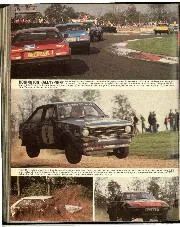
Donington Rallysprint
Patrick Tambay won the second Donington Rallysprint contest between Grand Prix drivers and rally stars at the end of October. This Eaton's Yale-sponsored TV spectacular involved Ari Vatanen, John Watson,…
The Rover SD1 supplanted the Ford Capri as the dominant car at the front of the British Saloon Car Championship in the early 1980s. Just as a period of Capri hegemony began with a change in engine rules, so another signalled the start of a new era with the SD1 at the forefront.
The introduction of a 3-litre engine capacity limit for 1976 outlawed the American big-bangers, such as the likes of Chevrolet’s Camaro, and made the Ford the car to have in the series that is known today as the British Touring Car Championship. An increase in maximum capacity to 3.5 litres for 1980 altered the landscape of the BSCC again.
The big Rover would go on to become one of the mainstays of the BSCC for more than half a decade
British Leyland motor sport boss John Davenport had lobbied for the increase, and in the face of 38 Capri wins in the 46 races since the start of 1976, his request was accepted. It still required some sleight of hand to get the SD1 into the series: the production version was 3531cc, yet the car was homologated at 3495cc.
The big Rover would go on to become one of the mainstays of the BSCC for more than half a decade. There were highs and lows on the way, and controversy by the bucketload. The SD1 was very much a winner, though. A first victory came at the Brands Hatch British Grand Prix support race in 1980 and its last in 1987. There were a pair of class titles and one overall crown – two if you count the Steve Soper victory in 1983 that was eventually wiped out in court nine months after the end of the season.
Davenport stayed close to home when he picked a team to take BL into the top class of the BSCC. David Price Racing, which had been running its Formula 3 programme with the Dolomite Sprint engine, was chosen to build and run the Group 11/2 cars.

The Rover was far from an instant success, however. Tyre and engine problems blighted the Rover’s maiden season, though Jeff Allam took victory number one at Brands in July thanks to a strategic call that would be impossible today. On a damp track, DPR sent him out on Michelin intermediates in place of the troublesome Dunlop covers the team was contracted to run.
Tom Walkinshaw Racing took over the programme for 1981, with Allam and Pete Lovett winning five races between them and the latter the class crown. Allam made it two titles in two years for TWR in ’82.
In 1983 Soper took the overall title at the end of a first season run to Group A regs, which was marked by protest, counter-protest and legal action. The final ruling to disqualify the SD1s on counts of bodywork and engine irregularities didn’t arrive until July, by which time the renamed Austin Rover Group had made a pre-emptive strike to withdraw from the BSCC and focus on the European Touring Car Championship.
Rover did finally win the overall title in 1984 with the Vitesse version of the SD1. Andy Rouse, who inherited the ’83 crown in his class B Alfa Romeo GTV6, had developed his own Rover and won seven championship rounds on the way to a repeat triumph.
The Rover continued its success in Europe. The TWR team would triumph in 11 races in 1985-86.
TWR built 18 Rovers for its various programmes, a number that included the conversion of a pair handed over by DPR, which also constructed two Group 2 cars. Multiple privateers also built Rovers, the likes of Patrick Motorsport, Andy Rouse Engineering and Dennis Leech, a crowd favourite with his black-and-orange liveried machines.
SD1s produced to Group 11/2, Group 2 and Group A regulations now have homes in a burgeoning tin-top historic scene. They are welcomed in Peter Auto’s Heritage Touring Cup for cars built between 1966 and ’84 and the Motor Racing Legends organisation’s Historic Touring Car Challenge, which has a later cut-off of 1990.

• Price new n/a
• Price now £100,000-£250,000
• Engine 3.5-litre normally aspirated V8
• Rivals Ford Capri III 3.0, BMW 635CSi, Volvo 240 Turbo, Jaguar XJS
• Verdict A classic tin-top racer that is increasingly a regular sight out on track today